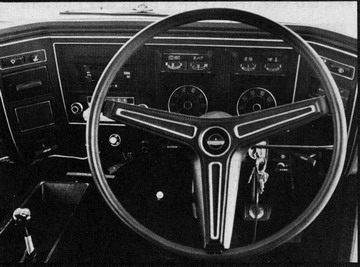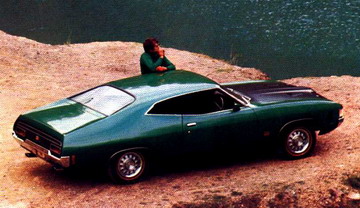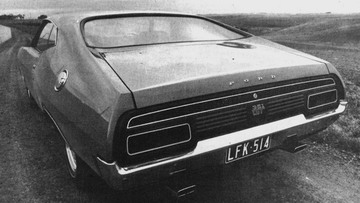GT
Information Article -
5
 In
December 1971, production of the all new ‘Australian’ designed XA range
of Falcons commenced and in keeping with tradition, a GT was included in the
model range. Changes from the previous model were dramatic, with totally new and
much sleeker body work covering only a mildly revised floor pan and
mechanicals. Externally and internally, the XAGT was completely different from
its predecessors in the way it looked and felt. Gone was the blunt, hard-edged
styling that was first introduced with the XR range, being replaced with a much
softer and smoother aerodynamic package.
In
December 1971, production of the all new ‘Australian’ designed XA range
of Falcons commenced and in keeping with tradition, a GT was included in the
model range. Changes from the previous model were dramatic, with totally new and
much sleeker body work covering only a mildly revised floor pan and
mechanicals. Externally and internally, the XAGT was completely different from
its predecessors in the way it looked and felt. Gone was the blunt, hard-edged
styling that was first introduced with the XR range, being replaced with a much
softer and smoother aerodynamic package.
Whilst the new model maintained the
111 in. wheelbase of the XY, the new XAs included increases in overall length
(1.9 in.), width (1.2 in.), front track (1.6 in.), rear track (1.5 in.) and
weight (14 lbs.). The only dimensional decreases, were to the overall height
(1.9 in.) and ground clearance (0.75 in.).
To help distinguish the XAGT from
other models in the range, the designers added functional bonnet scoops, fake
air intakes on the front guards, bonnet blackouts and a black accent line that
ran
along the sills, over the guards
and around the back of the car to include the rear indicator assemblies. In
standard form, the quarter window was also removed, however you could order your
car with quarter vents, if you liked.
As with the exterior, the interior
also came in for some dramatic changes. Initially noticeable was the new wrap
around style dash, which gave the driver the impression of sitting in the
cockpit of a plane. The instrument panel was dominated by the large 140 MPH
speedo and 8000 RPM tacho, with ancillary gauges for fuel, oil pressure, water
temperature and battery charge located above. The new seats were of a
high-backed design, which gave greater support and provided a built-in
headrest.

Mechanically, the XAGT was almost
identical to the XYGT when it was
introduced, using the same
fully imported 351 4V cleveland engine, although the 302 and 351 2V
Cleveland
V8 engines being put into the
lesser models,
were now being locally manufactured. Gearbox and differential combinations also
remained the same, as did the front disc/rear drum setup, although the XAs now
incorporated the brake proportioning valve setup previously found on the Phase
II & III GTHOs. In keeping with the changes to the appearance and to help take
advantage of the wider track, the suspension settings were softened to give a
ride that was both less harsh and quieter.
The standard 16 gallon fuel tank
found in the XY range was increased to 17.5 gallons for the XA, with the 36
gallon unit still being an option for the XAGT only. Standard wheels for the
XAGT returned to the ‘12 slot’ design previously found on the
early XWGTs but now being manufactured by ROH here in Australia. Tyres were
still the ER 70 x 14 HR size Dunlop SP Sport (Aquajets) radial ply
tyres. As with the XY Ford also continued the “Sports
Road Wheels” as an
option.
While the overall performance
figures for the new GT were much the same as it’s predecessor, with a top speed
of (122-129 MPH) and quarter mile times (15.1-15.8 sec.) there was actually an
improvement over the XYGT in the 0-100 MPH tests, with the XAGT recording times
around a second quicker (18.7-19.2 sec). Testers of the day put this
improvement down to the new slippery shape.
The XAGT
– HARDTOP
If the public were impressed with
the new four door version of the XAGT, the two door version really knocked their
socks off. Not since the XM-XP Falcon range had Ford produced a two door
Falcon, however with the success of the Monaro and Charger, Ford needed a
competitor to gain needed sales.
Dimensionally, the two door was the
same as the four door,
except for three areas; height (2 in. lower), width (3 in. wider) and weight (15
lbs. heavier). The extra width came at the rear wheel arches, which were aching
for a decent set of wide wheels and tyres. Following the demise of the Phase
IV, this was obviously going to be the weapon of choice for all Ford drivers.
Cosmetically, there was little
difference – apart from the obvious – between the two models, however the rear
of the hardtop was sharply chopped and tail lights were of a recessed design.
Production of the XAGTs
commenced in December 1971 for the four door models and July 1972 for
the two door models, with
production for both ceasing in September 1973. Total production of XAGTs was
2759, with 891 of these being hardtops.
 In
December 1971, production of the all new ‘Australian’ designed XA range
of Falcons commenced and in keeping with tradition, a GT was included in the
model range. Changes from the previous model were dramatic, with totally new and
much sleeker body work covering only a mildly revised floor pan and
mechanicals. Externally and internally, the XAGT was completely different from
its predecessors in the way it looked and felt. Gone was the blunt, hard-edged
styling that was first introduced with the XR range, being replaced with a much
softer and smoother aerodynamic package.
In
December 1971, production of the all new ‘Australian’ designed XA range
of Falcons commenced and in keeping with tradition, a GT was included in the
model range. Changes from the previous model were dramatic, with totally new and
much sleeker body work covering only a mildly revised floor pan and
mechanicals. Externally and internally, the XAGT was completely different from
its predecessors in the way it looked and felt. Gone was the blunt, hard-edged
styling that was first introduced with the XR range, being replaced with a much
softer and smoother aerodynamic package. 

